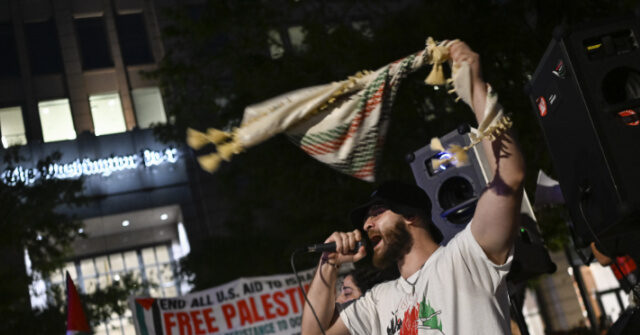On a recent Saturday evening, a distressing incident occurred outside the White House during a pro-Palestinian rally in Washington, D.C., when an individual attempted to set himself on fire. This shocking act of self-immolation was captured on video by Jessica Costescu, a reporter for the Washington Free Beacon, who shared footage on social media platform X. In the videos, the man, surrounded by police, voices troubling statements, including claims of spreading “misinformation” and identifying himself as a “journalist.” The scenario quickly escalated, drawing immediate attention from law enforcement and fellow rally-goers.
As the situation unfolded, reports indicated that the man exhibited visible signs of distress, including a burned arm. Witnesses attempted to assist him by pouring water over the affected area, illustrating the chaotic yet urgent response to the individual’s self-harming behavior. Further imagery from the scene revealed the aftermath, showing the man engulfed in flames moments before police and rally participants intervened to extinguish the fire. This horrifying act not only shocked onlookers but also sparked conversations about the implications of personal crises during public demonstrations.
Eyewitness accounts detailed how the incident occurred around 6:00 p.m. amidst the larger context of the pro-Palestinian protest. As police officers reacted quickly, two individuals joined forces, trying to suffocate the flames with shirts and traditional kaffiyehs. Despite their efforts, the man suffered injuries that required medical attention. The urgency of the situation highlighted the need for rapid intervention in the face of such life-threatening acts, emphasizing the volatile mix of personal anguish and political expression at public events.
Pamela A. Smith, the police chief for the Metropolitan Police Department, confirmed the incident in an official statement, clarifying that an adult male participating in the demonstration had attempted to set himself ablaze. Smith praised the quick actions of law enforcement and members of the public who succeeded in extinguishing the flames. Following the incident, emergency responders transported the man to a nearby hospital, where he was treated for injuries that, thankfully, were not life-threatening.
This incident raises crucial discussions surrounding mental health, protest culture, and the extreme measures individuals might resort to amid ongoing social and political tensions. The man’s assertion of being a journalist and spreading misinformation adds an additional layer of complexity to the narrative, drawing attention to the role of media and truth in contemporary sociopolitical discourse. With the pro-Palestinian protests echoing broader global sentiments, the man’s actions might be reflective of the intense emotions and frustrations many feel amid rapidly changing geopolitical landscapes.
In summary, the alarming event of self-immolation at the pro-Palestinian rally outside the White House serves as a stark reminder of the intertwining nature of personal despair with political activism. The incident exhibited the swift response of both police and bystanders in a moment of crisis, but it also highlights the urgent need for addressing mental health issues within activist communities. As society navigates the complexities of protest and personal expression, such incidents call for greater understanding and resources to prevent similar tragedies in the future.

